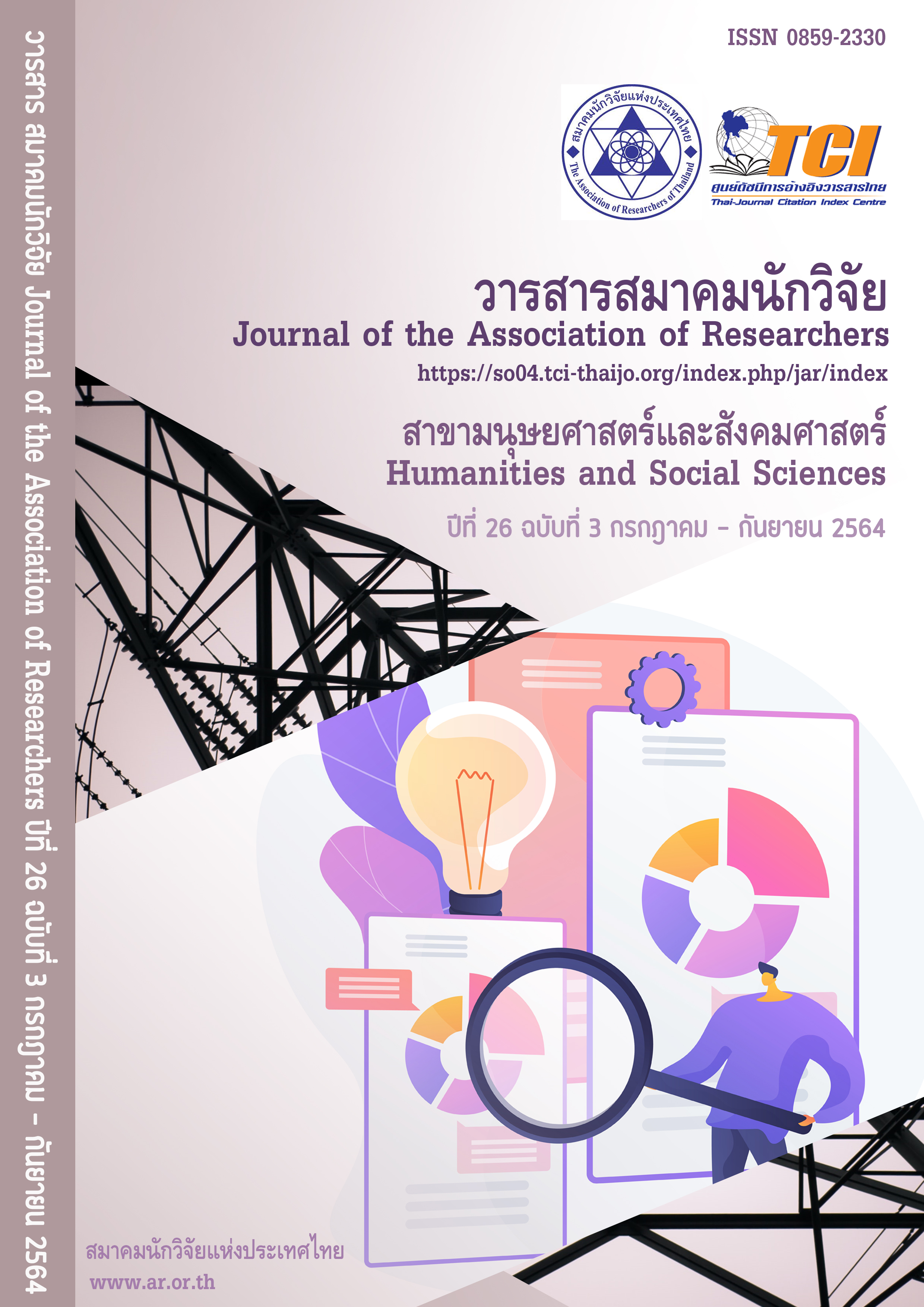Factors affecting the customer decision making on using M.R.T. Chaloem Ratchamongkhon Line in COVID – 19 pandemic period
Main Article Content
Abstract
This research aimed 1) to study the demographic factors affecting decision making on MRT Chaloem Ratchamongkhon Line in COVID – 19 pandemic period. 2) to study the marketing mix factors affecting decision making on MRT Chaloem Ratchamongkhon Line in COVID – 19 pandemic period. The samples were 404 commuters who have used MRT Chaloem Ratchamongkhon Line. A research tool was the questionnaires with a confidence index of 0.978. Also, the researcher used statistical analysis, which included t-test, one-way ANOVA, and multiple regression. The results of this research found that the largest number of respondents were male with ages between 21 – 30 years. Moreover, this group of respondents was the single status with Bachelor's degrees who worked in private companies and received average income between 20,001 – 30,000 Bath a month. Most of them who lived or worked in Bangkok were far from MRT station less than five kilometers on weekdays around 9.00 AM – 12.00 PM, and travel between Hua Lumphong station – Bang Sue station. The results of the hypothesis test revealed that respondents of demographic factors on the level of education and monthly average income had significantly affected decision making MRT Chaloem Ratchamongkhon Line usage. Furthermore, the marketing mix factors in terms of product, promotion, people, and the physical evidence had significantly affected decision-making MRT Chaloem Ratchamongkhon Line usage.
Article Details
บทความที่ปรากฏในวารสารนี้ เป็นความรับผิดชอบของผู้เขียน ซึ่งสมาคมนักวิจัยไม่จำเป็นต้องเห็นด้วยเสมอไป การนำเสนอผลงานวิจัยและบทความในวารสารนี้ไปเผยแพร่สามารถกระทำได้ โดยระบุแหล่งอ้างอิงจาก "วารสารสมาคมนักวิจัย"
References
กรมควบคุมโรค. ( 2563). สืบค้น 28 สิงหาคม 2563 เข้าถึงได้จาก https://ddc.moph.go.th/viralpneumonia /intro.php.
กรมควบคุมโรค. วันสืบค้น 19 เมษายน 2564. เข้าถึงได้จากhttps://ddcportal.ddc.moph.go.th/portal/apps/ opsdashboard/index.html#/20f3466e075e45e5946aa87c96e8ad65
การรถไฟฟ้าขนส่งมวลชนแห่งประเทศไทย. (30 สิงหาคม 2563). เข้าถึงได้จาก https://www. mrta .co.th/th/news/information/
ฉัตยาพร เสมอใจ. (2550). พฤติกรรมผู้บริโภค. ซีเอ็ดยูเคชั่น.
ยุวดี วรสิทธิ์ , และ เอก ชุณหชัชราชัย . (2559). ปัจจัยด้านคุณภาพบริการ และพฤติกรรมการใช้บริการรถไฟฟ้าแอร์พอร์ตเรลลิ้งก์ที่มีผลต่อทัศนคติของผู้ใช้บริการในกรุงเทพมหานคร. วารสารบริหารธุรกิจเทคโนโลยีมหานคร.
ราชกิจจานุเบกษา สืบค้น 30 สิงหาคม 2563 เข้าถึงได้จาก http://www.ratchakitcha.soc.go.th/DATA /PDF/2563/E/069/T_0001.PDF
วริศรา เจริญศรี. (2560). ปัจจัยที่มีอิทธิพลต่อการตัดสินใจใช้รถไฟฟ้าบีทีเอส. การศึกษาค้นคว้าอิสระเศรษฐศาสตร์มหาบัณฑิต มหาวิทยาลัยธรรมศาสตร์.
ศิริพงศ์ พฤทธิพันธุ์. (2562). พฤติกรรม ปัจจัยด้านส่วนประสมทางการตลาดและความพึงพอใจของผู้ใช้บริการระหว่าง บริษัท รถไฟฟ้า รฟท. จ ากัด (รฟฟท.:ARL) บริษัทระบบขนส่งมวลชนกรุงเทพ จ ากัด (มหาชน) (บีทีเอส: BTS) และการรถไฟฟ้าขนส่งมวลชนแห่งประเทศไทย (รฟม.: MRT). วารสารวิจัยและพัฒนา มหาวิทยาลัยราชภัฏสวนสุนันทา.
ศิริรัตน์ สะหุนิล , และ กิตติพันธ์ คงสวัสดิ์เกียรติ. (2556). การศึกษาความพึงพอใจในการใช้บริการรถไฟฟ้ าบีทีเอส. วารสารการเงิน การลงทุน การตลาด และการบริหารธุรกิจ.
ศิริวรรณ เสรีรัตน์. (2539). การบริหารการตลาดยุคใหม่. Diamond In Business World.
References
Anna Fraszczyk, Waressara Weerawat, และ Phumin Kirawanich. (2019). Commuters’ Willingness to Shift to Metro: a Case Study of Salaya, Thailand. Urban Rail Transit.
Bruin, J. (February 2011). UCLA: Statistical Consulting Group. เข้าถึงได้จาก https://stats.idre.ucla. edu/stata/ado/analysis/
Chang et al. (2021). Does COVID-19 affect metro use in Taipei? Journal of Transport geography.
Karl Kim. (2021). Impacts of COVID-19 on transportation: Summary and synthesis of interdisciplinary research. Transportation Research Interdisciplinary Perspectives.
Oded Cats Alejandro Tirachini. (2020). COVID-19 and Public Transportation: Current Assessment, Prospects, and Research Needs. Journal of Public Transport.
Philip Kotler. (2008). Principles of Marketing. Pearson Prentice Hall.
Philip Kotler, และ Kevin Keller. (2016). Marketing Management. Pearson Prentice Hall.
Witchayaphong et al. (2020). Influential Factors Affecting Travelers’ Mode Choice Behavior on Mass Transit in Bangkok, Thailand. Sustainability
Translated Thai References
Chachayaporn, S. (2007). Consumer Behavior, SE-ED Book Center.
Department of Disease control. (2020). Retrieved from https://ddc.moph.go.th/viralpneumonia/intro.php.
Department of Disease control. (2021). Retrieved from https://ddcportal.ddc.moph.go.th/portal/apps/opsdashboard/index.html#/20f3466e075e45e5946aa87c96e8ad65
Mass Rapid Transit Authority of Thailand.(2020). Retrieved from https://www.mrta.co.th/th/news/information/
Royal Thai Government Gazette.(2020). Retrieved from http://www.ratchakitcha.soc.go.th/DATA/PDF/2563/E/069/T_0001.PDF
Siripong, P. (2019). Behaviors, Marketing Mix Factors, and Customer Satisfaction of Riders among Airport Rail Link (ARL), Bangkok Mass Transit System Public Company Limited (BTS), and Mass Transit Authority of Thailand (MRT). Journal of Suan Sunandha Rajabhat University.
Siriwan Serirat(1995).Marketing Management, Diamond In Business World.
Sirirat, S. and Kittipan, K. (2013). Services Satisfaction Of BTS Skytrain. Journal Of Finance, Investment, Marketing, And Business Management.
Warissara, C. (2017). Factors Affecting Commuters’ Decision Making OF Using The Bangkok Sky Train. An Independent Study for the degree of Business Economics Thammasart University.
Yuwadee, W. and Ake, C. (2016). The factor of Service Quality and Passenger Behavior Effecting to Attitudes of Consumers in Bangkok Metropolitan. MUT Journal of Business Administration. (in Thai)


